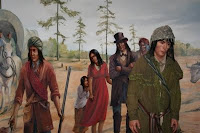 The last post on the Trail of Tears, this post is about the Cherokee removal. The title of this post comes from the account of an unnamed soldier who participated in the removal.
The last post on the Trail of Tears, this post is about the Cherokee removal. The title of this post comes from the account of an unnamed soldier who participated in the removal."I fought through the War Between the States and have seen many men shot, but the Cherokee Removal was the cruelest work I ever knew."The discovery of gold at Dahlonega in 1829 and demand for cotton plantations exacerbated a dire situation for the Cherokee who faced trespassing prospectors and division of lands into lots by Georgia government. In spite of legal battles, the Indian Removal Act 1830 and Treaty of New Echota signed by a group of Cherokee in 1835 gave the removal false legitimacy.
In 1836, some Cherokee (notably those who supported the Treaty signatories and by no means the majority) began their migration. Roughly 6,000 Cherokee had relocated by the end of 1836. The legality of the Treaty was in question and Ralph Waldo Emerson wrote to President Van Buren asking him not to inflict "...so vast an outrage upon the Cherokee Nation.”
In May 1838, the US Army rounded up 13,000 Cherokee at gunpoint from their homes into concentration camps near Cleveland, Tennessee. Those who didn't go were shot, those who did were beaten if they resisted. In these camps, dysentery was rife and there were deaths and soldiers deserted regularly. The plan was to send the Cherokee along three routes to Oklahoma.
This was a journey of almost 1200 miles, taken on foot, horse or wagon and boat. Along the way, Cherokees were assaulted and killed, charged exorbitant fees to use ferries. At Red Clay, the Cherokee were given hospital blankets infected with smallpox and as a result, the Cherokee were not allowed near towns, forcing them to prolong their journey.
The Cherokee nation's leader, John Ross negotiated with the US Army and asked that he would organise the removal, allowing them to travel and forage in smaller groups rather than the mass herding inflicted on other tribes. The groups of up to a thousand Cherokee were able to make the journey without extreme losses but death was still a constant companion on the journey.
It is commonly cited that 2000 Cherokee died in the camps and that another 2000 died on the trail of tears. Other estimates add up to 2000 more. The removal continued into the bitter winter of 1838 where Cherokee died of exposure waiting for a Kentucky river ferry that charged a dollar for a twelve-cent ride and twelve inches of ice covered the waters of South Illinois.
Along the way, the Cherokee sang 'Amazing Grace' to maintain morale - even today the song has special meaning to them. The Cherokee rose (Georgia's state flower) is said to have been found as a sign of hope for those Cherokee on the trail. The Cherokee who were removed settled at Tahlequah, Oklahoma and those who signed the Treaty of New Echota were assassinated.
Not all the Cherokee were removed, some 600 were given citizenship in North Carolina through the actions of a white store owner. Another 400 hid in the North Carolina mountains from federal troops and yet another 400 submitted to state laws. The vast majority of those who were removed still remember those who died on the Trail of Tears.




No comments:
Post a Comment